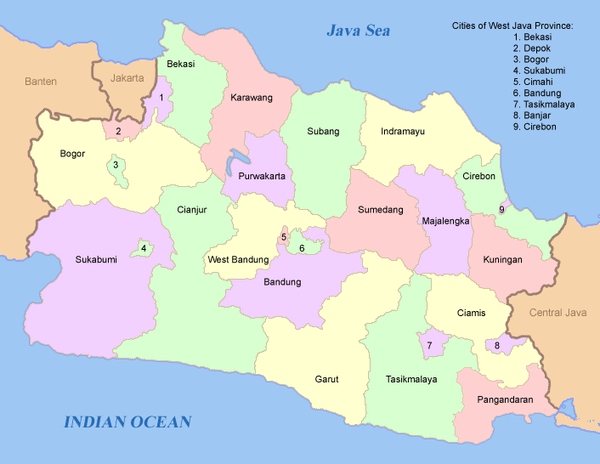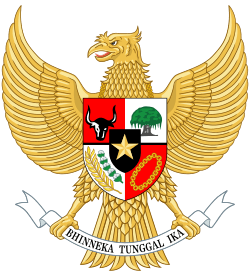West Java
West Java (Indonesian: Jawa Barat; Sundanese: ᮏᮝ ᮊᮥᮜᮧᮔ᮪) is a province of Indonesia on the western part of the island of Java, with its provincial capital in Bandung. West Java is bordered by the province of Banten and the country's capital region of Jakarta to the west, the Java Sea to the north, the province of Central Java to the east and the Indian Ocean to the south. The province is the homeland of the Sundanese people, the second-largest ethnic group in Indonesia after the Javanese.
West Java Jawa Barat | |
|---|---|
.svg.png) Flag  Coat of arms | |
 Location of West Java in Indonesia | |
| Coordinates: 6°45′S 107°30′E | |
| Established | 19 August 1945 |
| Re-established | 14 July 1950 |
| Capital | Bandung |
| Largest city | Bekasi |
| Government | |
| • Body | West Java Provincial Government |
| • Governor | Ridwan Kamil |
| • Vice Governor | Uu Ruzhanul Ulum |
| Area | |
| • Total | 35,377.76 km2 (13,659.43 sq mi) |
| Area rank | 21st in Indonesia |
| Highest elevation | 3,078 m (10,098 ft) |
| Lowest elevation | 0 m (0 ft) |
| Population (2020)[2] | |
| • Total | 49,935,858 |
| • Rank | 1st in Indonesia |
| • Density | 1,400/km2 (3,700/sq mi) |
| • Density rank | 2nd in Indonesia |
| Demographics | |
| • Ethnic groups | Sundanese (79%), Javanese (10%), Cirebonese (7%), Betawi (4%) |
| • Religion | Islam (97%), Christianity (1.81%), Buddhist (0.58%), Confucianism (0.22%), Hinduism (0.05%), Sunda Wiwitan |
| • Languages | Indonesian (official) Sundanese (native) Cirebonese (minority) Betawi (minority) |
| Time zone | UTC+7 (Indonesia Western Time) |
| ISO 3166 code | ID-JB |
| HDI | |
| HDI rank | 10th in Indonesia (2019) |
| GRP Nominal | |
| GDP PPP (2019) | |
| GDP rank | 3rd in Indonesia (2019) |
| Nominal per capita | US$ 3,048 (2019)[3] |
| PPP per capita | US$ 10,017 (2019)[3] |
| Per capita rank | 21st in Indonesia (2019) |
| Website | jabarprov |
West Java was one of the early eight provinces of Indonesia formed following the country's independence proclamation and was later legally re-established on 14 July 1950. In 1966, the city of Jakarta was split off from West Java as a 'special capital region' (Daerah Khusus Ibukota), with a status equivalent to that of a province,[4] while in 2000 the western parts of the province were in turn split away to form a separate Banten province.
Even following these split-offs, West Java is the most populous province of Indonesia with a population of 49,935,858 as of mid 2020.[5] The province's largest cities, Bekasi and Bandung, are the third and fourth most populous cities proper in Indonesia, respectively. As a satellite city within the Jakarta metropolitan area, Bekasi experiences a highly rapid population growth, having surpassed the West Java capital of Bandung in 2012. Nonetheless, Bandung remains one of the most densely populated city proper in the world, while Bekasi and Depok, both satellites of Jakarta, are respectively the seventh and tenth most populous suburbs in the world.[6]
History

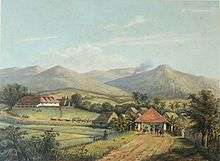
The oldest human inhabitant archaeological findings in the region were unearthed in Anyer (the western coast of Java) with evidence of bronze and iron metallurgical culture dating to the first millennium AD.[7] The prehistoric Buni culture (near present-day Bekasi) clay pottery were later developed with evidence found in Anyer to Cirebon. Artefacts (dated from 400 BC — AD 100), such as food and drink containers, were found mostly as burial gifts.[7] There is also archaeological evidence in Batujaya Archaeological Site dating from the 2nd century and, according to Dr Tony Djubiantono, the head of Bandung Archaeology Agency, Jiwa Temple in Batujaya, Karawang, West Java was also built around this time.
One of the earliest known recorded history in Indonesia is from the former Tarumanagara kingdom, where seven fourth century stones are inscribed in Wengi letters (used in the Pallava period) and in Sanskrit describing the kings of the kingdom Tarumanagara.[7] Records of Tarumanegara's administration lasted until the sixth century, which coincides with the attack of Srivijaya, as stated in the Kota Kapur inscription (AD 686).
The Sunda Kingdom subsequently became the ruling power of the region, as recorded on the Kebon Kopi II inscription (AD 932).[7]
An Ulama, Sunan Gunung Jati, settled in Cirebon, with the intention of spreading the word of Islam in the pagan town. In the meantime, the Sultanate of Demak in central Java grew to an immediate threat against the Sunda kingdom. To defend against the threat, Prabu Surawisesa Jayaperkosa signed a treaty (known as the Luso-Sundanese Treaty) with the Portuguese in 1512. In return, the Portuguese were granted an accession to build fortresses and warehouses in the area, as well as form trading agreements with the kingdom. This first international treaty of West Java with the Europeans was commemorated by the placement of the Padrao stone monument at the bank of the Ciliwung River in 1522.
Although the treaty with the Portuguese had been established, it could not come to realization. Sunda Kalapa harbour fell under the alliance of the Sultanate of Demak and the Sultanate of Cirebon (former vassal state of Sunda kingdom) in 1524, after their troops under Paletehan alias Fadillah Khan had conquered the city. In 1524/1525, their troops under Sunan Gunung Jati also seized the port of Banten and established the Sultanate of Banten which was affiliating with the Sultanate of Demak. The war between the Sunda kingdom with Demak and Cirebon sultanates then continued for five years until a peace treaty was made in 1531 between King Surawisesa and Sunan Gunung Jati. From 1567 to 1579, under the last king Raja Mulya, alias Prabu Surya Kencana, the Sunda kingdom declined, essentially under the pressure from Sultanate of Banten. After 1576, the kingdom could not maintain its capital at Pakuan Pajajaran (the present-day Bogor) and gradually the Sultanate of Banten took over the former Sunda kingdom's region. The Mataram Sultanate from central Java also seized the Priangan region, the southeastern part of the kingdom.
In the sixteenth century, the Dutch and the British trading companies established their trading ships in West Java after the falldown of Sultanate of Banten. For the next three hundred years, West Java fell under the Dutch East Indies' administration. West Java was officially declared as a province of Indonesia in 1950, referring to a statement from Staatblad number 378. On 17 October 2000, as part of nationwide political decentralisation, Banten was separated from West Java and made into a new province. There have been recent proposals to rename the province Pasundan ("Land of the Sundanese") after the historical name for West Java.[8][9]
Administrative divisions
.svg.png)
Since the creation of West Bandung Regency in 2008,[10] the Province of West Java has been subdivided into 9 cities (Indonesian: Kota) and 17 regencies (Indonesian: Kabupaten). These 26 cities and regencies are divided into 620 districts (Indonesian: Kecamatan), which comprise 1,576 urban villages (Indonesian: Kelurahan) and 4,301 rural villages (Indonesian: Desa).[10] An 18th regency was formed in October 2012 – Pangandaran Regency – from the southern half of Ciamis Regency; and on 25 October 2013, the Indonesian House of Representatives (DPR) began reviewing draft laws on the establishment of 57 prospective regencies (and 8 new provinces),[11] including a further three regencies in West Java – South Garut (Garut Selatan), North Sukabumi (Sukabumi Utara) and West Bogor (Bogor Barat) – but none of these three new regencies are shown separately on the map below, nor in the following table.
| Name | Capital | Area in Square km | Population 2005 estimate | Population 2010 Census | Population 2015 Census[12] | Population mid 2020 Estimate[13] |
|---|---|---|---|---|---|---|
| Bekasi City | 206.61 | 1,993,478 | 2,334,871 | 2,708,721 | 3,075,690 | |
| Bekasi Regency | Central Cikarang | 1,224.88 | 1,983,815 | 2,630,401 | 3,235,556 | 3,899,017 |
| Depok City | 200.29 | 1,374,903 | 1,738,570 | 2,099,989 | 2,484,186 | |
| Bogor City | 118.50 | 891,467 | 950,334 | 1,046,579 | 1,126,927 | |
| Bogor Regency | Cibinong | 2,710.62 | 3,829,053 | 4,771,932 | 5,463,849 | 6,088,233 |
| Sukabumi City | 48.25 | 291,277 | 298,681 | 317,883 | 330,691 | |
| Sukabumi Regency | Palabuhanratu | 4,145.70 | 2,168,892 | 2,341,409 | 2,433,265 | 2,470,219 |
| Cianjur Regency | Cianjur | 3,840.16 | 2,079,770 | 2,171,281 | 2,243,328 | 2,264,328 |
| West Bandung Regency (Bandung Barat) | Ngamprah | 1,305.77 | * | 1,510,284 | 1,627,816 | 1,714,982 |
| Cimahi City | 39.27 | 546,879 | 541,177 | 585,931 | 620,393 | |
| Bandung City | 167.27 | 2,288,570 | 2,394,873 | 2,480,615 | 2,510,103 | |
| Bandung Regency | Soreang | 1,767.96 | 4,037,274 | 3,178,543 | 3,528,873 | 3,831,505 |
| Garut Regency | South Tarogong | 3,074.07 | 2,196,422 | 2,404,121 | 2,546,859 | 2,636,637 |
| Tasikmalaya City | 171.61 | 582,423 | 635,464 | 657,169 | 663,986 | |
| Tasikmalaya Regency | Singaparna | 2,552.19 | 1,619,052 | 1,675,675 | 1,735,401 | 1,755,710 |
| Pangandaran Regency | Parigi | 1,680 | ** | 383,848 | 390,316 | 401,493 |
| Banjar City | 113.49 | 162,383 | 175,157 | 181,331 | 183,299 | |
| Ciamis Regency | Ciamis | 1,433.87 | 1,511,942 | 1,148,656 | 1,168,254 | 1,201,685 |
| Kuningan Regency | Kuningan | 1,110.56 | 1,045,691 | 1,035,589 | 1,054,862 | 1,087,105 |
| Cirebon City | 37.36 | 308,771 | 296,389 | 307,319 | 322,322 | |
| Cirebon Regency | Sumber | 984.52 | 2,044,257 | 2,067,196 | 2,124,866 | 2,209,633 |
| Majalengka Regency | Majalengka | 1,204.24 | 1,167,566 | 1,166,473 | 1,181,701 | 1,210,709 |
| Sumedang Regency | Sumedang | 1,518.33 | 1,014,019 | 1,093,602 | 1,136,816 | 1,154,428 |
| Indramayu Regency | Indramayu | 2,040.11 | 1,689,247 | 1,663,737 | 1,690,643 | 1,737,524 |
| Subang Regency | Subang | 1,893.95 | 1,380,047 | 1,465,157 | 1,527,952 | 1,612,576 |
| Purwakarta Regency | Purwakarta | 825.74 | 753,306 | 852,521 | 920,639 | 971,889 |
| Karawang Regency | West Karawang | 1,652.20 | 1,926,471 | 2,127,791 | 2,271,681 | 2,370,488 |
| Totals | 35,377.76 | 38,886,975 | 43,053,732 | 46,668,214 | 49,935,858 | |
- Notes
* – the 2005 population is included in the total for Bandung Regency, of which West Bandung Regency was formerly part.
** – the figures for Ciamis Regency include those for the new Pangandaran Regency, created in 2012.
Geography
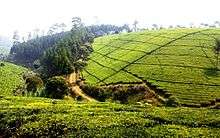
West Java borders Jakarta and Banten province to the west, and Central Java to the east. To the north is the Java Sea. To the south is the Indian Ocean. Unlike most other provinces in Indonesia which have their capitals in coastal areas, the provincial capital, Bandung, is located in the mountainous area in the centre of the province. Banten Province was formerly part of West Java Province but was created a separate province in 2000. West Java, in the densely populated western third of Java, is home to almost 1 out of every 5 Indonesians.
West Java and Banten provinces, as a part of the Pacific Ring of Fire, have more mountains and volcanoes than any of the other provinces in Indonesia. The vast volcanic mountainous region of inland West Java is traditionally known as Parahyangan (also known as Priangan or Preanger) which means "The abode of hyangs (gods)". It is considered as the heartland of the Sundanese people. The highest point of West Java is the stratovolcano Mount Cereme (3,078 meters) bordering Kuningan and Majalengka Regencies. West Java has rich and fertile volcanic soil. Agriculture, especially traditional dry rice cultivation (known as ladang or huma), has become the main way of life of traditional Sundanese people. Since the colonial VOC and Dutch East Indies era, West Java has been known as a productive plantation area for coffee, tea, quinine, and many other cash crops. The mountainous region of West Java is also a major producer of vegetables and decorative flowering plants. The landscape of the province is one of volcanic mountains, steep terrain, forest, mountains, rivers, fertile agricultural land, and natural sea harbours.[14]
Flowing through Bandung Basin to the northeast is Citarum River, the longest and most important river in the province. This 300-km long river is the site of 3 dams, namely Cirata Dam, Saguling Dam, and Jatiluhur Dam. The river is heavily polluted by industrial and household sewage to the point that it has been called as 'the world's dirtiest river' by some.
Economy
Initially, the economy of the Sundanese people in West Java relied heavily on rice cultivation. Ancient kingdoms established in West Java such as the Tarumanagara and Sunda Kingdom are known to have relied on rice taxes and agriculture revenues. The cycle of life of the ancient Sundanese people revolved around the rice crop cycle. Traditional rice harvest festivals such as the Seren Taun were important. The ancient goddess of rice, Nyai Pohaci Sanghyang Asri, is revered in Sundanese culture. Traditionally, Sundanese people often used dry rice cultivation (ladang). After the Mataram expanded to the Priangan area in the early 17th century following the Sultan Agung campaign against Dutch Batavia, sawah (wet rice cultivation) began to be adopted in the northern lowlands of West Java. Regencies such as Indramayu, Cirebon, Subang, Karawang and Bekasi are now well known as key rice producing areas. The mountainous region of West Java supplies vegetables, flower and many horticultural produce to Jakarta and Bandung. Animal farms in West Java produce dairy products and meats.
Colonial period
During the Dutch East India Company (VOC) and Dutch East Indies era, West Java fell under Dutch administration centered in Batavia. The Dutch colonial government introduced cash crops such as tea, coffee, and quinine. Since the 18th century, West Java (known as "De Preanger") was known as a productive plantation area, and became integrated with global trade and economy. Services such as transportation and banking were provided to cater for wealthy Dutch plantation owners. West Java is known as one of the earliest developed regions in the Indonesian archipelago. In the early 20th century, the Dutch colonial government developed infrastructures for economic purposes, especially to support Dutch plantations in the region. Roads and railways were constructed to connect inland plantations area with urban centers such as Bandung and port of Batavia.
Post independence
After Indonesian independence in 1945, West Java became a supporting region for Jakarta, the Indonesian capital. Jakarta remained as the business and political center of Indonesia. Several regencies and cities in West Java such as Bogor, Bekasi and Depok were developed as supporting areas for Jakarta and came to form the Greater Jakarta area or Jabodetabek (JAkarta, BOgor, DEpok, TAngerang and BEKasi). The northern area of West Java has become a major industrial area. Areas such as Bekasi, Cikarang and Karawang are sprawling with factories and industries. The area in and around Bandung also developed as industrial area.
Natural resources
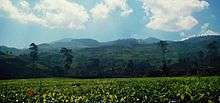
Based on the data from Indonesia State Secretary, the total area of rice fields in West Java Province in 2006 was 9,488,623 km which produced 9,418,882 tons of paddy in 2006, consisting of 9,103,800 tons rice field paddy and 315,082 tons farmland paddy. Palawija (non-rice food) production, reached 2,044,674 tons with productivity 179.28 quintal per ha. Nevertheless, the widest plant's width is for corn commodity which reaches 148,505 ha, West Java also produce horticulture consists of 2,938,624 tons vegetables, 3,193,744 tons fruits, and 159,871 tons medicines plants/ bio pharmacology.
Forest in West Java covers 764,387.59 ha or 20.62% from total size of the province. It consists of productive forest 362,980.40 ha (9.79%), protected forest 228,727.11 ha (6.17%), and conservation forest 172,680 ha (4.63%). Mangrove forest reaches 40,129.89 ha, and spread in 10 regencies where coasts are available. Besides, there is also another protected forest of about 32,313.59 ha organized by Perum Perhutani Unit III West Java and Banten.
From the productive forest, in 2006 West Java harvested crop of about 200,675 m³ wood, although the need of wood in this province every year is about 4 million m³. Until 2006, populace forest's width 214,892 ha with wood production is about 893,851.75 m³. West Java also produce non-forest's crop which is potential enough to be developed as forestry work, such as silk, mushroom, pine, dammar, maleleuca, rattan, bamboo, and swallow bird's nest.
In fishery sector, commodities include goldfish, nila fish, milkfish, freshwater catfish, windu shrimp, green mussel, gouramy, patin, seaweed and vaname shrimp. In 2006, this province harvested 560,000 tons fish from fishery cultivation crop and brackish or 63.63% from fishery production total in West Java.
In the poultry field, dairy cow, domestic poultry, and ducks are common commodities in West Java. 2006 data stated that there are 96,796 dairy cows (25% of the national population), 4,249,670 sheep, 28,652,493 domestic poultries, and 5,596,882 ducks (16% of the national population). Now there are only 245,994 beef cattle in West Java (3% national population), whereas the need every year is about 300,000 beef cattle.
This province has many plantation crops, such as tea, cloves, coconut, rubber, cacao, tobacco, coffee, sugar, palm and akar wangi (Chrysopogon zizanioides). From all those commodities, cloves, coconut, rubber, cocoa, tobacco, and coffee are common in West Java. From area side, the best productivity, that is plan area's width equals with plant's width that produces tobacco and sugar palm commodities. From production side, the highest productivity is oil palm (6.5 tons per ha) and sugar palm (5.5 tons per ha).
West Java also has a number of mining operations. In 2006, it contributed 5,284 tons zeolite, 47,978 tons bentonite, iron sand, pozzolan cement, feldspar, and jewel barn/ gemstone. Precious stone mining potential generally are found in Garut, Tasikmalaya, Kuningan, and Sukabumi Regency areas.
As consequences of has many volcanoes, West Java is potential of Geothermal energy. There are 11 points of geothermal energy and 3 points, i.e. Papandayan, Ceremai and Gede Pangrango have conducted pre-exploration.[15]
Raw natural resources include chalk, several offshore oilfields in the Java Sea, and lumber. Most of the province is very fertile, with a mix of small farms and larger plantations. There are several hydropower dams, including Jatiluhur, Saguling, Cirata, and Jatigede.
Tourism

Tourism is an important industry in West Java, and the Bandung and Puncak areas have long been known as popular weekend destinations for Jakartans. Today Bandung has developed into a shopping destination, popular not only among local Indonesian especially Jakartans, but also with neighboring Malaysian and Singaporean visitors.[16] The history-rich coastal city of Cirebon is also a cultural tourism destination since the city has several kratons and historical sites such as Gua Sunyaragi. Other tourist destinations include the Bogor Botanical Garden, Safari Park of Indonesia, Tangkuban Perahu crater, Pelabuhanratu Bay, Ciater hot springs, Kawah Putih crater to the south of Bandung, Pangandaran beach, and various mountain resorts in Cianjur, Garut, Tasikmalaya, and Kuningan.
Demographics
| Year | Pop. | ±% |
|---|---|---|
| 1971 | 21,623,529 | — |
| 1980 | 27,453,525 | +27.0% |
| 1990 | 35,384,352 | +28.9% |
| 1995 | 39,206,787 | +10.8% |
| 2000 | 35,729,537 | −8.9% |
| 2010 | 43,053,732 | +20.5% |
| 2020 | 49,935,858 | +16.0% |
| 2000 Census decline due to the splitting off of Banten as a separate province. Source: Statistics Indonesia 2010, Ministry of Health. Mid 2020 Estimate: Badan Pusat Statistik, Jakarta, 2020. | ||
The population of West Java was put at 43,054,000 in mid-2010 making it the most populous province of Indonesia, home to 18% of the national total on 1.8% of the national land.[17] Aside from the special district of Jakarta, it is the most densely populated province in the country with an average of 1,411.5 people per km² (2020 data). The population growth rate recorded in the ten years to 2010 was 1.9%,[18]
Ethnic and linguistic composition
West Java is the native homeland of Sundanese people which forms the largest ethnic group in West Java, followed by Javanese who migrated to the province centuries ago. Since Jakarta and the surrounding area, including West Java, is the business and political center of Indonesia, the province has attracted various people from throughout Indonesia. Other Native Indonesian ethnic groups such as Minangkabau, Batak, Malay, Madurese, Balinese, Ambonese and many other Indonesians who migrated to and settled in West Java cities can also be easily found. West Java urban areas also have a significant population of Chinese Indonesians.
In addition to Indonesian, the official national language, the other widely spoken language in the province is Sundanese. In some areas near the southern borders with Central Java, Javanese is also spoken. The main language spoken in Cirebon and nearby areas (Majalengka, Indramayu, Sumber) is Cirebonese, a dialect of Javanese with Sundanese influence.[19]
Indonesian is widely spoken as a second language.
Religion
Culture
The Sundanese share Java island with the Javanese people and primarily live in West Java. Although the Sundanese live in the same island as the Javanese, their culture is distinct and they likewise consider themselves to live in a separate cultural area called Pasundan or Tatar Sunda. Someone moving from West Java Province to Central or East Java Provinces is literally said to be moving from Sunda to Java worlds. Bandung, the capital city of West Java, is considered as the cultural heartland of Sundanese people. Many indigenous Sundanese artforms were developed in this city. The nearby province of Banten, which was formerly part of West Java before it became its own province, is similar in this regard and is also considered to be part of Pasundan as well.
Music
Gamelan orchestra
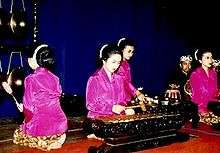
The musical arts of Sunda, which is an expression of the emotions of Sundanese culture, express politeness and grace of Sundanese. Degung orchestra consists of Sundanese gamelan.
In addition to the Sundanese forms of Gamelan in Parahyangan, the region of Cirebon retains its own distinct musical traditions. Amongst Cirebons' varying Gamelan ensembles the two most frequently heard are Gamelan Pelog (a non-equidistant heptatonic tuning system) and Gamelan Prawa (a semi-equidistant pentatonic tuning system). Gamelan Pelog is traditionally reserved for Tayuban, Wayang Cepak, and for listening and dance music of the Kratons in Cirebon. Whereas Gamelan Prawa is traditionally reserved for Wayang Purwa.
Cirebon also retains specialized Gamelan ensembles including: Sekaten, which is played in the Kratons to mark important times in the Islamic calendar. Denggung, also a Kraton ensemble which is believed to have a number of "supernatural powers". And Renteng, an ensemble found in both Cirebon and Parahyangan that is known for its loud and energetic playing style.
Zither ensembles
Tembang Sunda is a genre of Sundanese vocal music accompanied by a core ensemble of two kacapi (zither) and a suling (bamboo flute). Tembang means song or poem and Sunda is a geographical, historical, and cultural construct which signifies home for the Sundanese people of Indonesia. The music and poetry of tembang Sunda are closely associated with the Parahyangan (literally the abode of the gods), the highland plateau that transverses the central and southern parts of Sunda. The natural environment of Priangan, an agricultural region surrounded by mountains and volcanoes, is reflected in some songs of the tembang Sunda.[21]
Kacapi suling is tembang Sunda minus vocal.
Tarawangsa is a genuine popular art is performed on ensemble consists of tarawangsa (a violin with an end pin) and the jentreng (a kind of seven-stringed zither). It is accompanied by a secret dance called Jentreng. The dance is a part of a ritual celebrating the goddess of paddy Dewi Sri. Its ceremonial significance is associated with a ritual of thanksgiving associated with the rice harvest. Tarawangsa can also be played for healing or even purely for entertainment.
Bamboo ensembles
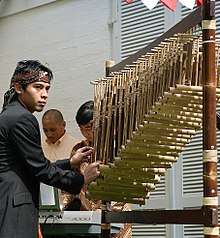
The three main types of Sundanese bamboo ensembles are angklung, calung, and arumba. The exact features of each ensemble vary according to context, related instruments, and relative popularity.
Angklung is a generic term for sets of tuned, shaken bamboo rattles. Angklung consists of a frame upon which hang several different lengths of hollow bamboo. Angklungs are played like handbells, with each instrument played to a different note. Angklung rattles are played in interlocking patterns, usually with only one or two instruments played per person. The ensemble is used in Sundanese processions, sometimes with trance or acrobatics. Performed at life-cycle rituals and feasts (hajat), angklung is believed to maintain balance and harmony in the village. In its most modern incarnation, angklung is performed in schools as an aid to learning about music.
The Angklung got more international attention when Daeng Soetigna, from Bandung, West Java, expanded the angklung notations not only to play traditional pélog or sléndro scales, but also diatonic scale in 1938. Since then, angklung is often played together with other western music instruments in an orchestra. One of the first well-known performances of angklung in an orchestra was during the Bandung Conference in 1955.
Like those in angklung, the instruments of the calung ensemble are of bamboo, but each consists of several differently tuned tubes fixed onto a piece of bamboo; the player holds the instrument in his left hand and strikes it with a beater held in his right. The highest-pitched calung has the greatest number of tubes and the densest musical activity; the lowest-pitched, with two tubes, has the least. Calung is nearly always associated with earthy humor, and is played by men.
Arumba refers to a set of diatonically tuned bamboo xylophones, often played by women. It is frequently joined by modern instruments, including a drum set, electric guitar, bass, and keyboards.
Puppetry
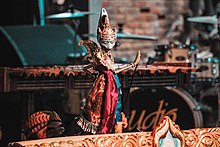
Wayang golek is a traditional form of puppetry from Sunda. Unlike the better-known leather shadow puppets (wayang kulit) found in the rest of Java and Bali, wayang golek puppets are made from wood and are three-dimensional, rather than two. They use a banana palm in which the puppets stand, behind which one puppeteer (dalang) is accompanied by his gamelan orchestra with up to 20 musicians. The gamelan uses a five-note scale as opposed to the seven-note western scale. The musicians are guided by the drummer, who in turn is guided by signals from the puppet master dalang gives to change the mood or pace required. Wayang golek are used by the Sundanese to tell the epic play "Mahabarata" and various other morality type plays.
Dance
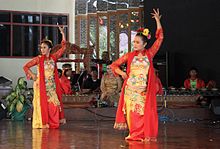
Sundanese dance shows the influence of the many groups that have traded and settled in the area over the centuries, and includes variations from graceful to dynamic syncopated drumming patterns, quick wrist flicks, sensual hip movements, and fast shoulder and torso isolations. Jaipongan is probably the most popular traditional social dance of Sundanese people. It can be performed in solo, in group, or in pair. The Tari Merak (Peafowl Dance) is a female dance inspired by the movements of a peafowl and its feathers blended with the classical movements of Sundanese dance.
Folktales and legend stories
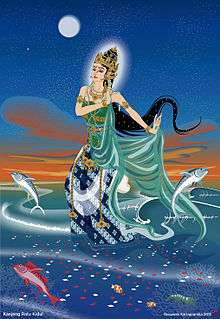
There are stories and folktales transcribed from Pantun Sunda stories.[22] Among the most well known folktale and stories are:
- Mundinglaya Dikusumah, which tells of Mundinglaya visiting Jabaning Langit to find layang Salaka Domas. It is a symbolic story of Surawisesa visiting Malaka to establish a peace treaty with the Portuguese before 1522.
- Lutung Kasarung, tells the life of a beautiful princess, in the era of Pasir Batang kingdom, a vassal of Sunda kingdom. She faces the evil of her older sister willing to seize her right as a queen.[23]
- Ciung Wanara, tells of the fight of two princes of Sunda kingdom and the history of Cipamali river (present-day Brebes river) as a boundary between Sundanese and Javanese territories.
- Sangkuriang, which tells the story of the creation of Mount Tangkuban Parahu and the ancient lake Bandung.[24]
- Nyai Loro Kidul (also spelled Nyi Roro Kidul) is a legendary female spirit or deity, known as the Queen of the Southern Sea of Java (Indian Ocean or Samudra Kidul south of Java island) in Sundanese as well in Javanese mythology.
Literature
Old Sundanese literature, among others, are:
- Bujangga Manik, which was written on 29 palm leaves and kept in the Bodleian Library in Oxford since 1627, mentioning more than 450 names of places, regions, rivers and mountains situated on Java island, Bali island and Sumatra island.[25]
- Carita Parahyangan, telling Sundanese kings and kingdoms from the pre-Islamic period.[25]
- Siksakandang Karesian, providing the reader with all kinds of religious and moralistic rules, prescriptions and lessons.[25]
Human Development Index

Cities and Regencies in West Java range high to medium Human Development Index (HDI).
Transportation
Toll roads
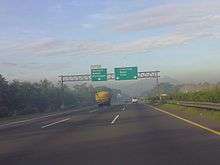
Due to its proximity to the capital city and its growing population and industry, West Java has the longest tolled highway road of any provinces. As of April 2015, there are several toll roads in West Java
- Jakarta–Cikampek Toll Road (73 km)
- Cipularang Toll Road (58.5 km)
- Padaleunyi Toll Road (33 km)
- Jagorawi Toll Road (46 km)
- Palimanan–Kanci Toll Road (28.8 km)
- Bogor Ring Road (partially built)
- Cinere–Jagorawi first section (3.7 km, as part of Jakarta Outer Ring Road 2)
- Kanci–Pejagan Toll Road (35 km)
- Cikopo–Palimanan Toll Road (116 km)
- Soreang–Pasir Koja Toll Road (10.6 km)
- Bogor–Ciawi–Sukabumi Toll Road (built: Bogor-Cigombong) (15.3 km)
In addition to completed highways there are some highways that are being built, one of them is Cileunyi–Sumedang–Dawuan (Cisumdawu) with length 60.1 kilometres.
Several other proposed toll roads are Bandung Intra-Urban Toll Road, Cileunyi–Tasikmalaya, and Jakarta Outer Ring Road 2 (a section of this road has been built).
Railways
Most cities and towns in West Java are served with narrow-gauge (mainly 1067mm) lines and connected to other provinces on Java Island. Jakarta's KRL Commuterline electric suburban trains run into the province to Bogor and Cikarang.
A high-speed railway, connecting Jakarta and Bandung, is now under construction.[27]
Air
Bandung Husein Sastranegara International Airport serves direct domestic flights to Batam, Pekanbaru, Medan, Bandar Lampung, Surabaya, Yogyakarta, Denpasar, Semarang, Banjarmasin, Makassar, and also international services to/from Kuala Lumpur and Singapore. The Kertajati International Airport in Majalengka Regency is built to replace the Husein Sastranegara Airport and to ease air traffic at Soekarno–Hatta International Airport in Jakarta.[28][29][30]
Education
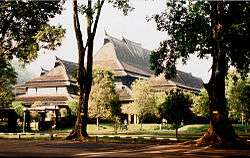
West Java is one of the most popular destinations for higher education in Indonesia. It has many well-known universities joined by many students from the entire country. Some of which are:
- Bandung Institute of Technology
- Bogor Agricultural University
- Indonesia University of Education
- Padjadjaran University
- Parahyangan Catholic University
- University of Indonesia
References
- "BPS-Laci 3.0". laci.bps.go.id. Retrieved 5 February 2019.
- Badan Pusat Statistik, Jakarta, 2020.
- "Indonesia". Badan Pusat Statistik. Retrieved 20 May 2020.
- "Jakarta". Encyclopædia Britannica Online. Encyclopædia Britannica, Inc. Retrieved 17 September 2007.
- Badan Pusat Statistik, Jakarta, 2020.
- "Estimasi Penduduk Menurut Umur Tunggal Dan Jenis Kelamin 2014 Kementerian Kesehatan" (PDF). Archived from the original (PDF) on 8 February 2014. Retrieved 20 February 2014.
- Zahorka, Herwig (2007). The Sunda Kingdoms of West Java, From Tarumanagara to Pakuan Pajajaran with Royal Center of Bogor, Over 1000 Years of Propsperity and Glory. Yayasan cipta Loka Caraka.
- "Tokoh Jawa Barat siapkan deklarasi Provinsi Pasundan." Okezome.com News. 29 October 2009. (in Indonesian)
- "Deklarasi Provinsi Pasundan." Radar Cirebon Online. (in Indonesian)
- Governance of West Java. West Java Government. 2008. p. 17.
- Jakarta Post, 14 November 2013
- Intermediate Census of 1 May 2015: Badan Pusat Statistik, 2018.
- Badan Pusat Statistik, 2020.
- Taylor (2003), p. 123.
- W Java to explore eleven geothermal spots – ANTARA News
- Post, The Jakarta. "AirAsia's Tony Fernandes keen for world to see Indonesia". The Jakarta Post. Retrieved 28 May 2019.
- Data is from the 2010 Indonesian national census.
- As between the 2000 and 2010 national censuses.
- Cohen, Matthew Isaac (March 2005). "The Arts of Cirebon". Seleh Notes. 12 #2: 6.
- "Population by Region and Religion in Indonesia". BPS. 2010.
- Zanten, Wim van (1989). Sundanese Music in the Cianjuran Style. KITLV Press.
- Noorduyn, J. (2006). Three Old Sundanese poems. KITLV Press. p. 11.
- Eringa, F. S. (1949). Loetoeng kasaroeng: een mythologisch verhaal uit West-Jawa. Verhanddelingen va heit KITL, Leiden.
- Terada, Alice M. (1994). "The Story of Sangkuriang," The Magic Crocodile and Other Folktales from Indonesia. University of Hawaii Press. pp. 60–64.
- Noorduyn, J. (2006). Three Old Sundanese poems. KITLV Press.
- "Badan Pusat Statistik Provinsi Jawa Barat". jabar.bps.go.id. Retrieved 21 December 2019.
- "High-speed train project progress reaches 7.6 percent". 28 August 2018.
- "Angkasa Pura II Named Kertajati Airport Operator". Tempo. Retrieved 24 July 2017.
- "Angkasa Pura II to Operate Kertajati, West Java's Biggest Airport". Jakarta Globe. Archived from the original on 25 July 2017. Retrieved 24 July 2017.
- Praditya, Ilyas Istianur (14 September 2017). "Bandara Kertajati Bakal Kurangi Kepadatan Soekarno-Hatta". liputan6.com. Retrieved 22 May 2018.
Bibliography
- Taylor, Jean Gelman (2003). Indonesia. New Haven and London: Yale University Press. ISBN 0-300-10518-5.
External links
| Wikivoyage has a travel guide for Western Java. |
| Wikimedia Commons has media related to West Java. |
